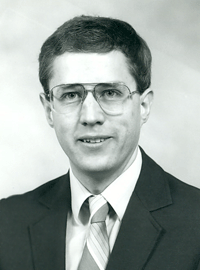In July 2023, we changed our name from AACC (short for the American Association for Clinical Chemistry) to the Association for Diagnostics & Laboratory Medicine (ADLM). The following page was written prior to this rebranding and contains mentions of the association’s old name. It may contain other out-of-date information as well.
 1995 Outstanding Scientific Achievements by a Young Investigator
1995 Outstanding Scientific Achievements by a Young Investigator
David S. Hage will receive the 20th annual award, sponsored by Boehringer Mannheim Corporation.
David S. Hage is assistant professor of analytical and bioanalytical chemistry at the University of Nebraska–Lincoln. He received his B.S. in chemistry and biology from the University of Wisconsin–La Crosse in 1983 and his Ph.D. in analytical chemistry from Iowa State University in 1987. From 1987 to 1989, he was a postdoctoral fellow in clinical chemistry at the Mayo Clinic. He began his present position at the University of Nebraska in 1989. He has been a member of AACC since 1988.
Hage is the author of 27 research publications and has written four book chapters dealing with various instrumental methods of chemical analysis. Over the last 4 years, he has also been responsible for writing a biennial review on immunoassays for Analytical Chemistry. His previous awards include a George Holmes Fellowship from the University of Nebraska, a Graduate Analytical Fellowship from the American Chemical Society, and a Noble–Hines Fellowship from Iowa State University. In addition, he is a past recipient of the Alpha Chi Sigma and Graduate Research Excellence Awards from Iowa State University.
Research in Hage’s laboratory involves the development of new methods for the separation and analysis of clinical samples based on either high-performance liquid chromatography (HPLC) or capillary electrophoresis (CE). One HPLC method of particular interest to his group is the technique of high-performance affinity chromatography (HPAC). An application of HPAC currently being examined by them is the use of the method in the development of automated immunoassays. Examples of his work in this area include prototype systems developed for the determination of intact parathyrin in plasma and albumin in urine. He has also been active in examining the theory and optimization of these techniques through use of computer simulations and work with model chromatographic systems.
Another major area of research in Hage’s laboratory concerns the use of HPLC and CE for characterizing the interactions of drugs and hormones with their binding proteins in blood. Hage’s group examined the binding of human serum albumin with the separate chiral forms of thyroxine, warfarin, tryptophan, and ibuprofen. These studies have provided new insights regarding these binding processes and have resulted in the development of several new approaches and techniques for the separation and study of chiral molecules.